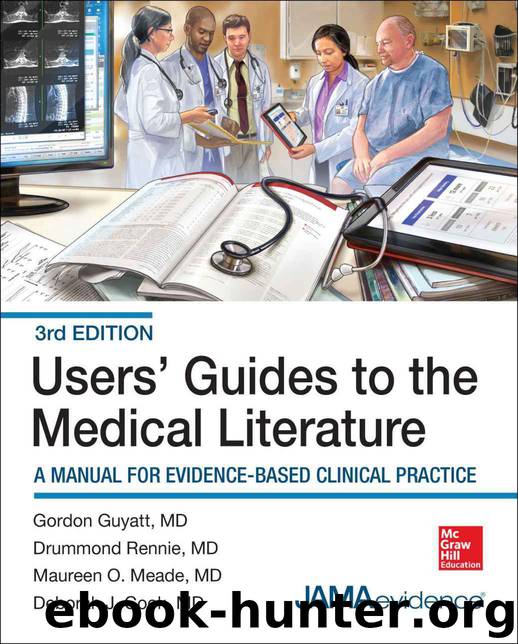Users' Guides to the Medical Literature: A Manual for Evidence-Based Clinical Practice, 3E (Users Guides to the Medical Literature) by Gordon Guyatt

Author:Gordon Guyatt
Language: eng
Format: mobi
Publisher: McGraw-Hill Education
Published: 2014-10-21T16:00:00+00:00
Examining Figure 15.1-1, you can see that, in general, patients who score well on the walk test also tend to score well on the cycle ergometer exercise test, and patients who score poorly on the cycle ergometer tend to score poorly on the walk test. However, you can find patients who represent exceptions, scoring better than most other patients on one test but not as well on the other test. These data, therefore, represent a moderate relationship between 2 variables: the walk test and the cycle ergometer exercise test.
One can summarize the strength of a relationship between 2 continuous (also called interval) variables in a single number, the Pearson correlation coefficient. The Pearson correlation coefficient, which is denoted by r, can range from –1.0 to 1.0. A correlation of 1.0 or –1.0 occurs when there is a perfect linear relationship between the 2 scores, such that one is completely predictable from the other. A correlation coefficient of –1.0 corresponds to a perfect negative relationship, whereby higher scores on test A are associated with lower scores on test B. A correlation coefficient of 1.0 corresponds to a perfect positive relationship, whereby higher scores on test A are associated with higher scores on test B. A correlation coefficient of 0 denotes no relationship between the 2 variables (ie, the scores on test A and the scores on test B fall in a random pattern). Typically, when calculating a correlation coefficient, a linear relationship between the variables is assumed. There may be a relationship between the variables, but it may not take the form of a straight line when viewed visually. For example, even if larger scores on the variables are found together, one may increase more slowly than the other for low values but will increase more quickly than the other for high values. If there is a strong relationship but it is not a linear one, the correlation coefficient may be misleading.
In the example depicted in Figure 15.1-1, the relationship appears to approximate a straight line, and the r value for the correlation between the walk test and the cycle ergometer is 0.50. Should the clinician be pleased and comfortable or displeased and uncomfortable with this moderately strong correlation? It depends on how we wish to apply the information. If we were thinking of using the walk test value as a substitute for the cycle ergometer—after all, the walk test is much simpler to perform—we would be disappointed. A correlation of 0.8 or higher (although the threshold is arbitrary) would be required for us to be confident in that kind of substitution. If the correlation were too low, there would be too much risk that a person with a high walk test score would have mediocre or low performance on the cycle ergometer test or that a person who did poorly on the walk test would do well on the cycle ergometer test. On the other hand, if we assume that the walk test gives a good indication of exercise capacity
Download
This site does not store any files on its server. We only index and link to content provided by other sites. Please contact the content providers to delete copyright contents if any and email us, we'll remove relevant links or contents immediately.
| Administration & Medicine Economics | Allied Health Professions |
| Basic Sciences | Dentistry |
| History | Medical Informatics |
| Medicine | Nursing |
| Pharmacology | Psychology |
| Research | Veterinary Medicine |
Good by S. Walden(3347)
The Social Psychology of Inequality by Unknown(2766)
The Checklist Manifesto by Atul Gawande(2657)
0041152001443424520 .pdf by Unknown(2595)
The Meaning of the Library by unknow(2385)
Guns, Germs and Steel by Diamond Jared(2197)
23:27 by H. L. Roberts(2141)
Borders by unknow(2117)
Being Mortal: Medicine and What Matters in the End by Atul Gawande(2037)
And the Band Played On by Randy Shilts(2014)
A Leg to Stand On by Oliver Sacks(1934)
The Hot Zone by Richard Preston(1910)
The Valachi Papers by Peter Maas(1762)
The Laws of Medicine by Siddhartha Mukherjee(1689)
The Andromeda Strain by Michael Crichton(1631)
The Obesity Epidemic by Robyn Toomath(1603)
Get What's Yours for Medicare: Maximize Your Coverage, Minimize Your Costs by Philip Moeller(1553)
Pharmacy Practice and The Law by Richard Abood(1493)
The Plague and I by Betty Macdonald(1451)
